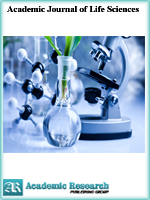Academic Journal of Life Sciences
Online ISSN: 2415-2137
Print ISSN: 2415-5217
Print ISSN: 2415-5217
Quarterly Published (4 Issues Per Year)

Archives
Volume 2 Number 11 November 2016
Comparative Anti-Nutrient Composition and Anti-Peroxidative Activities of Various Parts of Candle Bush (Senna Alata Linn) Plant
Authors: Folake Lucy Oyetayo ; Olatunde Abass Oseni ; Temitope A. Kupoluyi
Pages: 84-88
Abstract
The study compared the antinutritive, antimicrobial and anti-peroxidative activities of the leaf, seed and root of the Candle bush (Senna alata (Linn)) plant in vitro. The plant parts were air-dried and analysed according to standard methods. The leaf was found to contain significantly higher concentration (P≤0.05) of oxalate (8.24±0.57 mg/g) than the seed (3.06±0.00 mg/g) or root (3.29±0.06 mg/g) while Tannin concentration was significantly higher in the seed (9.89±1.17 mg/g) than the leaf (7.42±0.00 mg/g) or root (0.16±0.00 mg/g). Phytate concentration was significantly higher in the root (3.29±0.00 mg/g) than the leaf (1.92±0.04 mg/g) or seed (0.3±0.04 mg/g).The root of the plant showed a significantly higher (P≤0.05) anti-peroxidative ability (35.82±0.00%) than the leaf (19.66±0.36%) or seed (31.84±0.70%). The aqueous and ethanolic extracts of the plant parts were screened against some bacteria isolates. The ethanolic extract of the leaf showed higher zones of inhibition than the aqueous extract on all organisms tested except on E.coli and P. aeruginosa. Futhermore, the ethanolic extract of the seed showed a higher inhibition on Salmonella typhii, Staphylococus aureus and Clostridium spp. while the aqueous extract of the seed showed higher inhibitory effect on E.coli, P.aeruginosa and B.subtilis. The ethanolic extract of the root showed a higher inhibitory activity against all tested organisms compared to the aqueous extract. Hence, the foregoing shows the plant as a rich source of antinutritive components with potential therapeutic and antimicrobial properties which could replace the conventional synthetic drugs, the cost of which is getting out of reach of large populations in the developing world.



